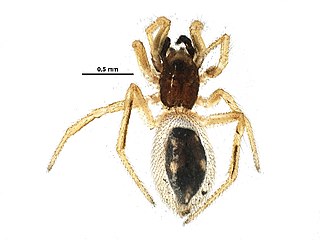Related Research Articles

Manduca quinquemaculata, the five-spotted hawkmoth, is a brown and gray hawk moth of the family Sphingidae. The caterpillar, often referred to as the tomato hornworm, can be a major pest in gardens; they get their name from a dark projection on their posterior end and their use of tomatoes as host plants. Tomato hornworms are closely related to the tobacco hornworm Manduca sexta. This confusion arises because caterpillars of both species have similar morphologies and feed on the foliage of various plants from the family Solanaceae, so either species can be found on tobacco or tomato leaves. Because of this, the plant on which the caterpillar is found does not indicate its species.

Manduca is a genus of moths in the family Sphingidae, the hawkmoths. The genus is used as a model in the biological sciences. The tobacco hornworm and the tomato hornworm in particular have been well studied. The genus was erected by Jacob Hübner in 1807.
Urophora quinquemaculata is a species of tephritid or fruit flies in the genus Urophora of the family Tephritidae.
Ortalis quinquemaculata is a species of ulidiid or picture-winged fly in the genus Ortalis of the family Tephritidae.

Hyposmocoma quinquemaculata is a species of moth of the family Cosmopterigidae. It was first described by Lord Walsingham in 1907. It is endemic to the island of Hawaii. The type locality is Kona, where it was collected at an elevation of 4,000 feet (1,200 m).

Mutilla is a genus of parasitoid wasp belonging to the family Mutillidae.
Eunidiini is a tribe of longhorn beetles of the subfamily Lamiinae. It was described by Téocchi et al. in 2010.
Eunidia is a genus of longhorn beetles of the subfamily Lamiinae.
Eunidia fallaciosa is a species of beetle in the family Cerambycidae. It was described by Stephan von Breuning in 1939. It is known from Somalia.
Eunidia spilotoides is a species of beetle in the family Cerambycidae. It was described by Stephan von Breuning in 1939.
Eunidia subannulicornis is a species of beetle in the family Cerambycidae. It was described by Stephan von Breuning in 1968.
Eunidia annulata is a species of beetle in the family Cerambycidae. It was described by Per Olof Christopher Aurivillius in 1924.
Eunidia brunneopunctata is a species of beetle in the family Cerambycidae. It was described by Per Olof Christopher Aurivillius in 1911. It is known from South Africa, Malawi, Angola, Kenya, Ethiopia, Mozambique, Botswana, Sudan, Namibia, Senegal, the Democratic Republic of the Congo, Tanzania, Somalia, and Uganda.
Eunidia haplotrita is a species of beetle in the family Cerambycidae. It was described by Per Olof Christopher Aurivillius in 1911.
Eunidia kristenseni is a species of beetle in the family Cerambycidae. It was described by Per Olof Christopher Aurivillius in 1911. It is known from tropical Africa.
Eunidia batesi is a species of beetle in the family Cerambycidae. It was described by Olliff in 1889.
Eunidia caffra is a species of beetle in the family Cerambycidae. It was described by Fahraeus in 1872.
Eunidia strigata is a species of beetle in the family Cerambycidae. It was described by Fahraeus in 1872. It contains the varietas Eunidia strigata var. damarensis.
M. quinquemaculata may refer to:

Euryopis quinquemaculata is a species of cobweb spider in the family Theridiidae. It is found in the United States.
References
- ↑ BioLib.cz - Eunidia quinquemaculata. Retrieved on 8 September 2014.
| This Eunidiini article is a stub. You can help Wikipedia by expanding it. |